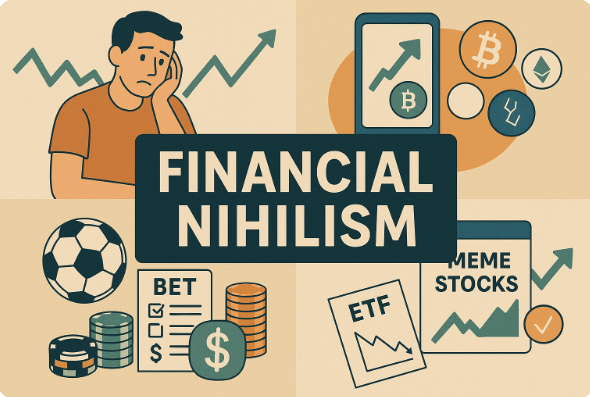The Mood: “If the game is rigged, why play it straight?”
Between stubborn housing costs, uneven wage gains, and the sense that traditional milestones keep drifting out of reach, it’s not hard to see why some younger investors look past index funds toward lottery-ticket strategies. Deloitte’s 2025 global survey found nearly half of Gen Z and Millennials don’t feel financially secure—up sharply from last year
“Financial nihilism” has become the label for this shift: the belief that prices are untethered from fundamentals, so speculation is as good as—maybe better than—prudence. The term has circulated in finance media for years and was popularized in long-form discussions by analyst Demetri Kofinas
Where the Energy Went: Speculation over strategy
1) Crypto & meme assets
Crypto ownership in the U.S. has plateaued around 17% of adults, with usage concentrated among younger men—evidence of both persistent curiosity and a narrowing cohort of true believers.
What’s new: prediction markets built on crypto rails surged during the 2024–25 cycle, and regulated versions are gaining traction. Kalshi has been growing volumes as a CFTC-authorized platform; Polymarket—long the poster child—has been moving back toward U.S. compliance. Regardless of the venue, the line between “investing” and “betting” keeps blurring.
2) Options & the 0DTE addiction
U.S. options volume has hit record territory again, driven in part by zero-days-to-expiration (0DTE) contracts. Cboe estimates retail traders now account for ~50–60% of SPX 0DTE trading, a sign that day-lottery dynamics are not just institutional. Academic and exchange research continues to show that retail, on average, loses money trading options, particularly in short-dated contracts.
3) Leveraged ETFs (the “triple-shot” product)
FINRA and the SEC have been explicit for years: leveraged/inverse ETFs reset daily and are generally inappropriate for buy-and-hold investors. Compounding and volatility decay make long holding periods risky, even when the headline index rises.
4) Sports betting & prediction trades
Legal sports betting has exploded: Americans legally wagered $149.9B on sports in 2024, producing $13.78B in operator revenue—a mainstream money flow that didn’t exist at this scale five years ago. Big tent-pole events (e.g., the Super Bowl) keep smashing records, normalizing betting as a weekly ritual.
Why the “YOLO” math feels logical (even when it isn’t)
- Housing affordability hit historic lows in 2023 and remains strained, especially for first-time buyers. When a typical household can’t qualify for a median-priced home, 8%-per-year index returns feel too slow.
- Real wages have improved modestly lately, but the long-run story is mixed and uneven by income tier—fueling the perception that “working harder” doesn’t move the needle.
Put simply: when compounding looks too small to matter, jackpot behavior starts to look rational.
The Hidden Costs of the “Bet Big” Playbook
- Volatility taxes your time horizon. The more your account swings, the more likely you are to sell low and chase high.
- Products aren’t neutral. 0DTE options and leveraged ETFs are engineered for short-term trading, not long-term compounding; the math quietly works against holders.
- House edge, just digitized. Sportsbooks and prediction platforms earn spreads and fees—the edge that funds their splashy promos. A record industry handle is not a sign that customers are getting rich.
A Better Blueprint: Keep the upside, cut the ruin risk
1) Barbell your risk
Allocate 80–90% to durable wealth engines—broad stock index funds, diversified bond exposure, and (when feasible) retirement accounts with employer matches. Keep 10–20% for “exploration capital” (individual stocks, a sliver of crypto, even a small prediction-market stake). You scratch the risk itch without endangering your future.
2) Put time back on your side
- Automate monthly contributions (even $50–$100).
- Use target-date or all-in-one asset-allocation funds if rebalancing feels overwhelming.
- Keep a 3–6 month cash buffer to avoid forced selling.
3) Rules for any high-octane trade
- No single speculative position >1–2% of net worth.
- No margin. No “all-in.” No averaging down on leverage.
- If you can’t explain the payoff diagram (options) or the daily reset (leveraged ETFs) in plain English, you don’t own it.
4) Reframe the goal
You’re not trying to beat the market every week; you’re trying to own the market for decades while your career income grows and your savings rate climbs. The aim is freedom, not fireworks.
Quick Reference: What to know about each “hot” strategy
| Strategy |
What it really is |
Typical trap |
Safer alternative |
| Meme stocks/alt-coins |
Narrative momentum |
Concentration + liquidity risk |
Core index + small speculative sleeve |
| 0DTE options |
Event-lottery exposure |
High expected loss for retail |
Longer-dated options only after deep study—or skip entirely Cboe Global Markets+1 |
| Leveraged ETFs |
Daily-reset leverage |
Compounding decay over time |
Plain ETFs; consider occasional hedges, not holdings FINRA |
| Sports betting/prediction markets |
Entertainment with a spread |
Negative expected value |
Invest in skills & assets with positive expected value |
If you only remember five facts
- Nearly half of Gen Z/Millennials report feeling financially insecure in 2025—context for the “YOLO” impulse.
- U.S. adults with crypto exposure remain about 17%, skewed young and male—interest is real but not universal.
- Sports betting is mainstream: $149.9B legally wagered in 2024. That’s an industry, not a shortcut to wealth.
- Retail now drives ~50–60% of SPX 0DTE activity; research shows retail option traders generally lose over time.
- Leveraged/inverse ETFs are built for daily objectives—not long-term holding.
The Takeaway
Financial nihilism is an understandable reaction to a tough economy and a loud market. But the math hasn’t changed: discipline beats drama. Keep most of your money compounding quietly; keep your curiosity contained in a small, pre-budgeted sandbox. That’s how you protect the floor and still leave the ceiling open.
